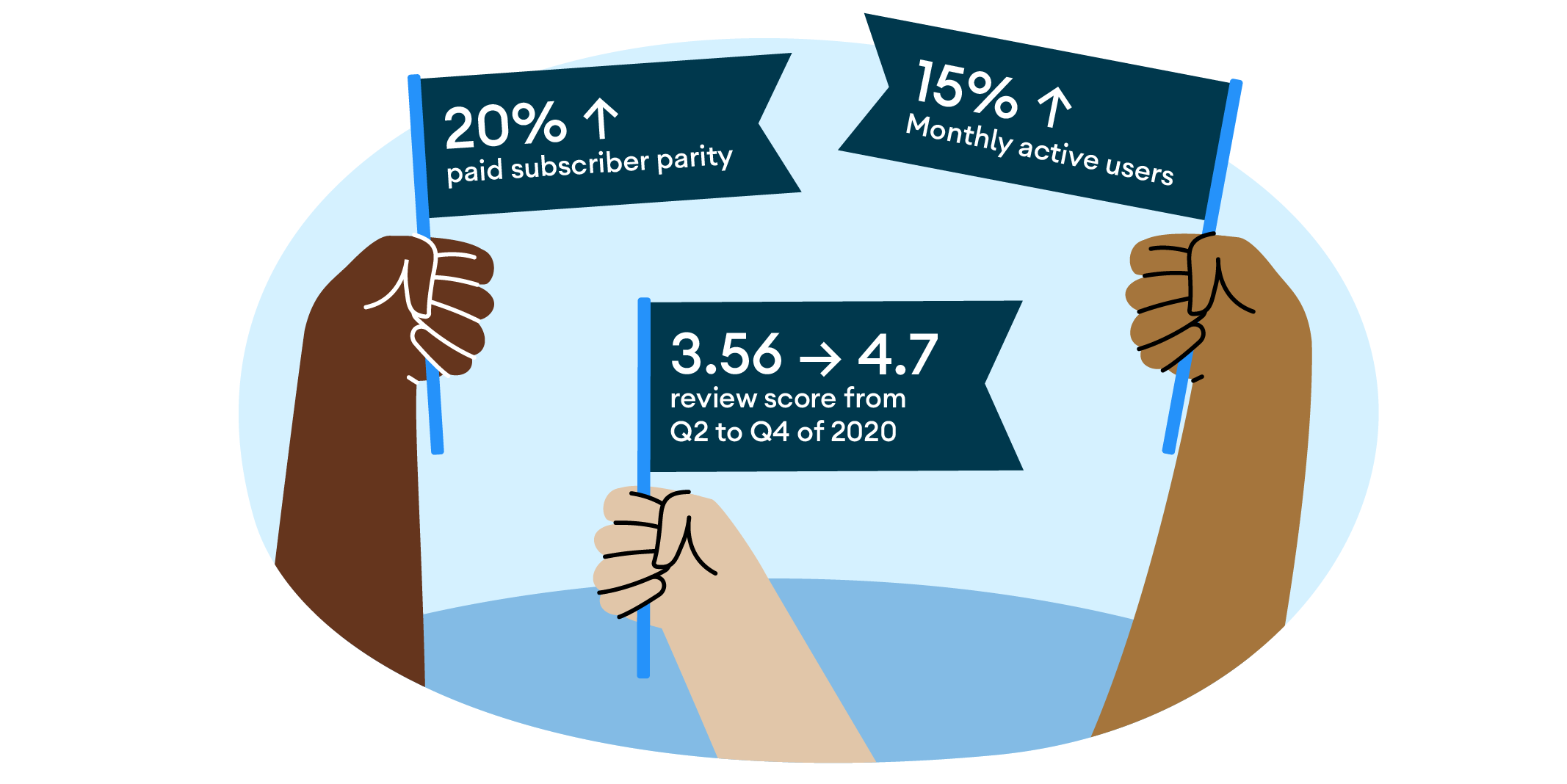Headspace 在 Android 重新启动后,月活跃用户数增加了 15%
使用集合让一切井井有条
根据您的偏好保存内容并对其进行分类。
正念不是在真空中发生的,它可以通过某种方式与一个人生活中的方方面面建立联系。Headspace 开发了全球首款冥想应用之一,现已成为正念领域的领军者,最近一直在围绕这一整体愿景不断发展完善。2019 年,他们决定将其应用拓展到冥想之外,并添加新的健身和健康功能。Headspace 意识到,他们需要一支由工程师和设计师组成的跨职能团队,才能实现新的产品愿景,并为用户打造卓越的应用体验。该公司迎来了一个激动人心的新阶段:其设计团队开始这一过程,先使用全新设计为新体验打造原型。
阻止 Headspace 拓展应用及进一步拓展用户视野的唯一因素就是他们现有的软件架构。它的结构不够清晰,无法支持所有这些新功能。事实上,Headspace 的开发团队预计在他们当前代码的基础上进行构建比完全重写需要更长的时间。他们决定冻结当前 Android 应用的开发工作,全身心地投入到彻底的整改工作中。
他们是如何做到的
Headspace 的 Android 开发团队需要一种便捷的方法,对其构建功能的方式进行标准化。在查阅 Google 资料,了解最新的 Android 开发和应用架构最佳实践后,他们找到了自己的解决方案。Google 建议使用 model-view-view-model 重构其应用。MVVM 是一种受到广泛支持的软件模式,并且正在逐渐成为业界标准,因为它允许开发者明确分离开发领域,有助于简化应用架构。选择 MVVM 给 Headspace 带来了一系列新的标准和最佳实践,帮助加快了开发速度。
该团队借力于 Google 的另一个重要资源是 Android Jetpack 库,其中包括用于依赖项注入的 Dagger 和 Hilt。新方法使得样板代码更小、更高效,从而提升了团队的工作效率。他们还借此机会将其应用完全迁移到了 Kotlin 编程语言。通过使用 Kotlin,该团队将应用的测试覆盖率从约 15% 提高到了 80%。扩大测试覆盖率有助于加快部署速度、提高代码质量并减少崩溃。
为确保改进后的用户体验能够体现在其商品详情评价中,Headspace 实施了 Google Play In-App Review API。利用以下新的 API,他们可以鼓励所有用户在应用内分享对 Headspace 体验的评价。这种实现提高了评价得分,而且由于商品详情评价与 Google Play 上的曝光度相关联,还有助于吸引用户关注该应用近期的改进。如需从技术层面深入探究 Headspace 重新启动的情况,请查看技术案例研究并与您的开发团队分享。
成果
该团队在 8 个月内完成了重写,并且能够提供设计原型中的每项功能。他们实现了最初的目标,即在健身和健康领域吸引新受众,同时不牺牲品质的声誉。评价和订阅数量激增,这都意味着用户体验更好,用户群也更加快乐。
Headspace 新专注于 Android 应用卓越奖,在所有指标上实现了显著的提升。
通过提升应用质量,其应用发布操作系统之间的付费订阅者等价比例提高了 20%;新的评价方法使其商品详情的评价数量从 2020 年第二季度的 3.56 提高到 4.7。得益于经过改进的评价以及新功能和更出色的用户体验,全球的月活跃用户数增加了 15%。在内部,新架构还让 Headspace 为未来的开发创建更快、更有信心的工作流。现在,他们减少了测试和修复 bug 的时间,将更多时间用于实现新功能。最近,他们改进了留存率流程并优化了追加销售流程。通过重写,还可以更好地集成深层链接和营销工具。得益于这项优势,Headspace 的团队能够从更多用户那里收集更优质的数据,直接回复反馈者,并根据这些反馈推动未来的开发工作。
Headspace 大胆尝试,对 Android App Excellence 进行了大量投资,同时开辟了健身和健康领域激动人心的新领域。凭借坚实的新开发基础和来自用户的最新反馈,Headspace 能够践行自己的使命:改善所有人的健康状况。
开始使用
如需了解如何重写应用以提供更好的用户体验,请参阅 Headspace 技术案例研究。此外,请访问“卓越应用”着陆页,详细了解一致、直观的应用用户体验如何助力您的业务蓬勃发展。
本页面上的内容和代码示例受内容许可部分所述许可的限制。Java 和 OpenJDK 是 Oracle 和/或其关联公司的注册商标。
最后更新时间 (UTC):2021-09-27。
[null,null,["最后更新时间 (UTC):2021-09-27。"],[],[],null,["# Headspace's Android reboot increases monthly active users by 15%\n\nMindfulness doesn't happen in a vacuum --- it has a way of connecting to every other part of a person's life. [Headspace](https://play.google.com/store/apps/details?id=com.getsomeheadspace.android&gl=US), which created one of the world's first meditation apps and is now a leader in the mindfulness space, has been evolving recently with that holistic vision in mind. In 2019, they decided to expand their app beyond meditation and add new fitness and wellness features. Headspace realized that they would need a cross-functional team of engineers and designers to be able to deliver on the new product vision and create an [excellent app experience for users](https://android-developers.googleblog.com/2021/08/working-towards-android-app-excellence.html). An exciting new phase for the company: their design team started the process by creating prototypes for the new experience, with fresh new designs.\n\nThe only thing stopping Headspace from expanding their app and further broadening their user's horizons was their existing software architecture. It wasn't clearly structured enough to support all these new features. In fact, Headspace's development team projected that building on their current code would take longer than a complete rewrite. They decided to freeze development of their current Android app and dedicate themselves fulltime to a total overhaul.\n\nHow they did it\n---------------\n\nHeadspace's Android development team needed a convenient way to standardize how they built features. While immersing themselves in Google's literature on the latest, best practices for Android development and [app architecture](/jetpack/guide), they found their solution. Google recommended refactoring their app using [model-view-view-model](/jetpack/guide). MVVM is a widely supported software pattern that is progressively becoming industry standard because it allows developers to clearly separate areas of development, helping streamline an app's architecture. Choosing MVVM provided Headspace with a new set of standards and best practices that helped speed up development.\n\nAnother key resource from Google that the team drew on were the [Android Jetpack](/jetpack) libraries, including [Dagger](/training/dependency-injection/dagger-android) and [Hilt](/training/dependency-injection/hilt-android) for dependency injection. The new approach made boilerplate code smaller and more efficient, improving the team's productivity. They also took the opportunity to fully migrate their app to the Kotlin programming language. Using Kotlin, the team increased the test coverage in the app from approximately 15% to 80%. The increased test coverage resulted in faster deployments, higher quality code, and fewer crashes.\n\nTo make sure this improved user experience was reflected in their store listing reviews, Headspace implemented the [Google Play In-App Review API](/guide/playcore/in-app-review). This new API allowed them to encourage all users to share reviews of their Headspace experience from within the app. The implementation increased review scores, and, because store listing reviews are [tied to visibility on Google Play](/topic/performance/vitals), it also helped draw attention to the app's recent improvements. For a technical deep dive on Headspace's reboot, check out and share the [technical case study](https://android-developers.googleblog.com/2021/09/investing-in-app-excellence-headspaces.html) with your development team.\n\nResults\n-------\n\nThe team completed the rewrite in eight months, and they were able to deliver every feature from the design prototype. They met their initial goal of reaching new audiences in the fitness and wellness spaces, without compromising their reputation for quality. A new surge of reviews and subscriptions spoke to a better user experience and a happier user base.\n\nHeadspace's new focus on [Android App Excellence](/quality) yielded measurable improvements across all metrics. \n\nThe improvements to the quality of the app led to a 20% increase in paid subscriber parity between operating systems where their app is published, and the new approach to reviews drove an increase in their store listing reviews from 3.56 to 4.7 from Q2 to Q4 of 2020. Visibility from improved reviews combined with new features and an improved user experience lead to a 15% increase in monthly active users globally. Internally, the new architecture also allowed Headspace to create faster and more confident workflows for future development. Now, they spend a lot less time testing and fixing bugs, and more time implementing new features --- most recently, an improved retention flow, and optimizations to the upsell process. The rewrite also allowed better deep linking and marketing tool integration. This benefit gave Headspace's team the ability to gather better data from more users, respond directly to those who give feedback, and use this feedback to inform future development.\n\nHeadspace took the plunge and made a significant investment in Android App Excellence while opening up exciting new areas in fitness and wellness. With a strong new foundation for development and fresh feedback from their users, Headspace is well positioned to continue their mission: improve everyone's health and happiness.\n\nGet started\n-----------\n\nTo discover how to rewrite your app to deliver a better user experience, see the [Headspace technical case study](https://android-developers.googleblog.com/2021/09/investing-in-app-excellence-headspaces.html). And, visit the [App Excellence landing page](/quality) to learn more about how consistent, intuitive app user experiences can grow your business."]]


